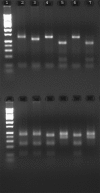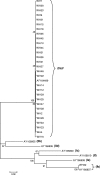Evidence supporting zoonotic transmission of Cryptosporidium spp. in Wisconsin
- PMID: 17005736
- PMCID: PMC1698413
- DOI: 10.1128/JCM.01067-06
Evidence supporting zoonotic transmission of Cryptosporidium spp. in Wisconsin
Abstract
Cryptosporidium hominis and Cryptosporidium parvum are the primary species of Cryptosporidium that infect humans. C. hominis has an anthroponotic transmission cycle, while C. parvum is zoonotic, infecting cattle and other ruminants, in addition to humans. Most cryptosporidiosis outbreaks in the United States have been caused by C. hominis, and this species is often reported as the primary cause of cryptosporidiosis in this country. However, outbreaks account for only 10% of the overall cryptosporidiosis cases, and there are few data on the species that cause sporadic cases. The present study identified the species/genotypes and subgenotypes of Cryptosporidium in 49 cases of sporadic cryptosporidiosis in Wisconsin during the period from 2003 to 2005. The species/genotype of isolates was determined by PCR restriction fragment length polymorphism analysis of the 18S rRNA and Cryptosporidium oocyst wall protein genes. The C. parvum and C. hominis isolates were subgenotyped by sequence analysis of the GP60 gene. Forty-four of 49 isolates were identified as C. parvum, and 1 was identified as C. hominis. Of the remaining isolates, one was identified as being of the cervine genotype, one was identified as being a cervine genotype variant, and two were identified as being of a novel human genotype, previously reported as W17. Nine different subgenotypes were identified within the C. parvum species, and two of these were responsible for 60% of the cases. In this study we found that most sporadic cases of cryptosporidiosis in Wisconsin are caused by zoonotic Cryptosporidium species, indicating that zoonotic transmission could be more frequently associated with sporadic cases in the United States.
Figures



References
-
- Blears, M. J., N. J. Pokorny, R. A. Carreno, S. Chen, S. A. De Grandis, H. Lee, and J. T. Trevors. 2000. DNA fingerprinting of Cryptosporidium parvum isolates using amplified fragment length polymorphism (AFLP). J. Parasitol. 86:838-841. - PubMed
-
- da Silva, A. J., S. Caccio, C. Williams, K. Y. Won, E. K. Nace, C. Whittier, N. J. Pieniazek, and M. L. Eberhard. 2003. Molecular and morphologic characterization of a Cryptosporidium genotype identified in lemurs. Vet. Parasitol. 111:297-307. - PubMed
-
- Dietz, V., D. Vugia, R. Nelson, J. Wicklund, J. Nadle, K. G. McCombs, and S. Reddy. 2000. Active, multisite, laboratory-based surveillance for Cryptosporidium parvum. Am. J. Trop. Med. Hyg. 62:368-372. - PubMed
Publication types
MeSH terms
Substances
Associated data
- Actions
- Actions
- Actions
- Actions
- Actions
- Actions
- Actions
- Actions
- Actions
LinkOut - more resources
Full Text Sources
Medical
Molecular Biology Databases
Miscellaneous

